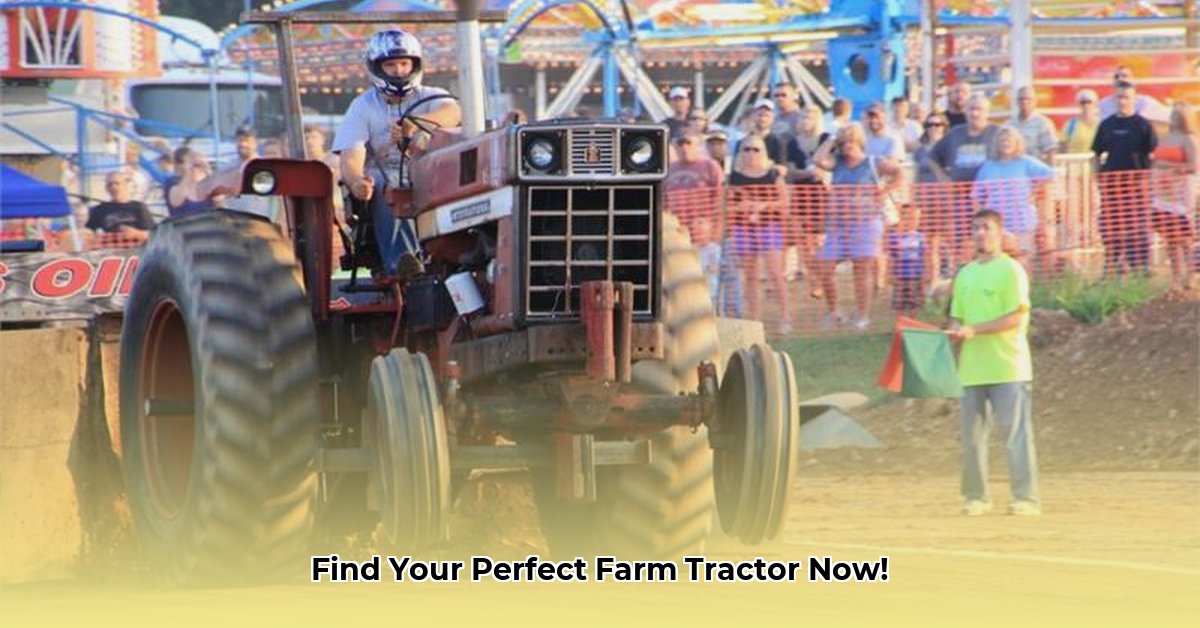
Hot Farm Pulling Tractor for Sale: Your Guide to a Winning Machine
Ready to dominate the tractor pulling circuit? This isn't your grandpa's farming equipment; competitive tractor pulling demands highly modified machines built for power and endurance – think Formula 1 of the agricultural world. This guide helps you find the perfect hot farm pulling tractor and understand what makes a champion machine. We'll explore modifications, buying considerations, and maintenance tips – your roadmap to victory. For even more tips and tricks, check out this helpful resource: Ultimate Tractor Pulling Guide.
Understanding the Beast: More Than Just a Tractor
Competitive tractor pulling demands more than just raw horsepower; it requires a finely tuned machine built for brute strength and durability. These aren't your average farm tractors; they’re highly modified, precision-engineered beasts designed to pull incredible weights. The modifications are extensive, creating a complex interplay of power, durability, and weight management.
Key Modifications: Unleashing the Power
Several key modifications transform a standard tractor into a competitive pulling powerhouse. Let's delve into these crucial upgrades:
Engine Enhancements: The Heart of the Matter
The engine is paramount. Increasing engine displacement (making it bigger) boosts power by allowing more air and fuel into the cylinders. Consider the jump from a standard 400 cubic inches to a massive 510 cubic inches! Turbochargers (e.g., Precision Turbo) or superchargers (e.g., Mike Janis) force extra air in, further amplifying power. However, increased power often means higher fuel consumption. Alcohol fuel is popular for maximum power but significantly increases running costs—a trade-off between performance and budget. High-performance fuel injection systems (e.g., Hillborn or Hypermax) precisely control fuel delivery for optimized performance. Isn't it fascinating how these modifications work together to create a powerhouse?
Drivetrain Upgrades: Getting the Power to the Ground
A powerful engine is useless without a drivetrain to handle the immense stress. Custom gear ratios (from manufacturers like Farmer or Atlas) optimize pulling performance in varying conditions. Reinforced transmissions (modified Allison or Ford 9000) and high-capacity clutches (e.g., a 2-disc MC Cloud clutch) are crucial for preventing slippage and catastrophic failure under heavy loads. The rear end also needs reinforcement, often with foam-filled versions and custom ring and pinion gear ratios (e.g., 16/49, 13/49, 13/52) that fine-tune power delivery for optimal performance. How much torque can these upgraded components really handle?
Weight Reduction: Every Pound Counts
Weight is the enemy in tractor pulling. Reducing weight improves the power-to-weight ratio, boosting acceleration and pulling ability. Think of it as racing – lighter vehicles are faster. Methods include using lighter materials like aluminum (frames, oil pans, valve covers), employing lightweight front ends (like Farmall lightweight lower front-ends), and removing unnecessary components like the PTO (Power Take-Off). How significant is the impact of even a small weight reduction on performance?
Decoding the Market: Popular Choices and Aftermarket Parts
International Harvester tractors are popular due to their robust frames which serve as excellent bases for modifications; however, many other makes and models are successfully modified. The vibrant aftermarket parts industry offers countless customization options, creating unique builds—making finding comparable tractors for sale more challenging, but potentially more rewarding.
Checklist for Buying a Used Hot Farm Pulling Tractor
Buying a used competitive pulling tractor demands diligence. This step-by-step guide helps you make a sound investment:
- Comprehensive Inspection: Thoroughly examine the engine, transmission, and rear end for wear and tear using the checklist. Listen for unusual noises.
- Review Documentation: Request complete maintenance records and competition history for insights into performance, maintenance, and potential issues.
- Test Drive (If Possible): Observe performance and responsiveness under load.
- Ask Questions: Don't hesitate to ask detailed questions about modifications, maintenance, and known problems.
- Professional Assessment: Consider a pre-purchase inspection from a qualified mechanic experienced with agricultural equipment.
Common Issues to Watch For
Even with care, used tractors can have problems: Engine wear (look for fatigue and overheating), transmission problems (check shifting and leaks), and rear-end wear (inspect for wear and unusual noises).
Making Your Choice: Finding Your Winning Machine
Choosing the right tractor involves budget, skill level, and competition goals. Research thoroughly, ask questions, and conduct a detailed inspection. A well-maintained, expertly modified tractor is an investment in your competitive success. Good luck!
How to Optimize Tractor Pulling Engine Cooling for Maximum Horsepower
Overheating is a major performance limiter and safety concern. Efficient cooling is vital, especially with heavily modified engines and water/alcohol injection systems. This is often overlooked when optimizing for horsepower. Upgrading the radiator, using high-flow water pumps, and adding auxiliary cooling systems are imperative to maintain optimal operating temperatures.